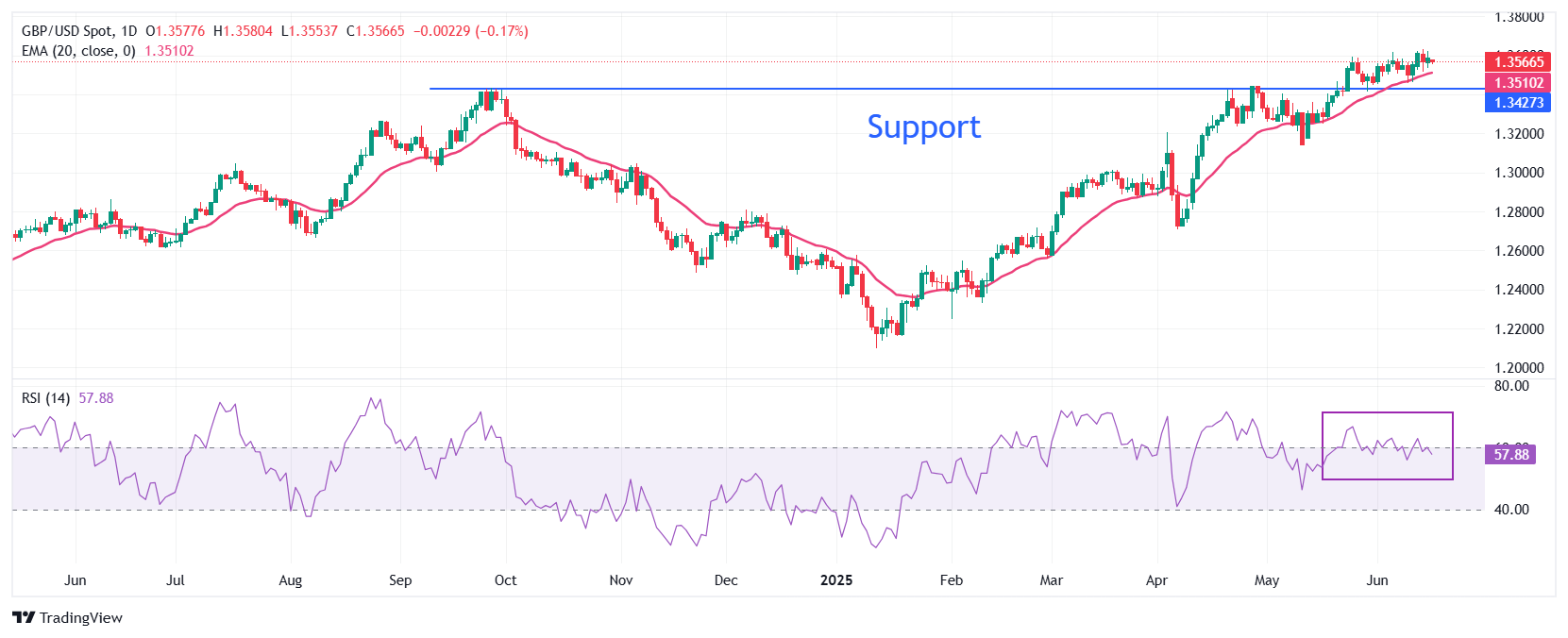Pound Sterling Trades Sideways Against US Dollar Amid Israel-Iran Conflict
- The Pound Sterling wobbles around 1.3565 against the US Dollar, with investors seeking fresh cues on the Israel-Iran war outlook.
- Investors expect the Fed and the BoE to leave interest rates steady this week.
- The UK inflation is expected to have grown moderately in May.
The Pound Sterling (GBP) trades in a limited range around 1.3565 against the US Dollar (USD) during European trading hours on Tuesday. The GBP/USD pair consolidates as the US Dollar (USD) turns sideways, while investors seek fresh cues on the future of the conflict between Israel and Iran.
At the time of writing, the US Dollar Index (DXY), which tracks the Greenback’s value against six major currencies, wobbles around 98.15.
Earlier in the day, a report from Reuters showed that Iran sought after its Middle East peers to urge United States (US) President Donald Trump to push Israeli Prime Minister Benjamin Netanyahu for an immediate ceasefire.
Following Tehran’s urge, Trump has asked US Vice President JD Vance and the Middle East envoy to push for meeting with the Iranians this week at the sidelines of the G7 meeting, The New York Times reported.
Meanwhile, the tussle between Iran and Israel enters its fifth day. The Israeli military said during late Asian hours on Tuesday that they had identified missiles launched from Iran toward Israel, according to the BBC News.
The demand for safe-haven assets, such as the US Dollar, increases amid heightening geopolitical tensions.
Daily digest market movers: Pound Sterling ranges againt US Dollar
- Another reason behind the sideways trend between the Pound Sterling and the US Dollar is the upcoming monetary policy announcements by the Federal Reserve (Fed) and the Bank of England (BoE), which are scheduled for Wednesday and Thursday, respectively.
- According to the CME FedWatch tool, the Fed is almost certain to leave interest rates steady in the range of 4.25%-4.50% this time. Traders are increasingly confident that the central bank will keep borrowing rates on hold as officials have stated that monetary policy adjustments are inappropriate until they get clarity on how much new economic policies will impact inflation and affect the outlook.
- The major highlight of the Fed’s policy will be the dot plot, which shows where officials see interest rates heading in the near and long term. In the last release of the dot plot in March, officials anticipated at least two interest rate cuts by the year-end. Apart from that, investors will also focus on the monetary policy statement and Fed Chair Jerome Powell’s press conference to know when the central bank could start reducing interest rates.
- In Wednesday’s monetary policy announcement, the Fed will also show forecasts on inflation and economic growth. It will be interesting to watch the degree of change in these key economic triggers amid the implementation of new policies by US President Trump.
- In the United Kingdom (UK), the Bank of England (BoE) is also expected to keep interest rates steady at 4.25% as officials guided a “gradual and cautious” monetary easing approach in thMay’s policy meeting, following an interest rate reduction by 25 basis points (bps).
- However, market participants expect that the BoE could reassess its monetary policy guidance, given recent cracks in the UK labor market. Latest employment data showed an increase in the Unemployment Rate and slower job growth as business owners reduced labor force to offset the impact of an increase in employers’ contribution to social security schemes.
- Ahead of the BoE monetary policy announcement, investors will focus on the UK Consumer Price Index (CPI) data for May, which will be released on Wednesday. The inflation data is expected to show that price pressures have cooled down.
Technical Analysis: Pound Sterling consolidates below 1.3600
(Click on image to enlarge)

The Pound Sterling wobbles inside Monday’s trading range around 1.3565 against the US Dollar on Tuesday. The GBP/USD pair struggles to revisit the three-year high around 1.3630. The near-term trend of the Cable remains bullish as the 20-day Exponential Moving Average (EMA) slopes higher around 1.3508.
The 14-day Relative Strength Index (RSI) struggles to break decisively above 60.00. A fresh bullish momentum would emerge if the RSI holds above that level.
On the upside, the 13 January 2022 high of 1.3750 will be a key hurdle for the pair. Looking down, the horizontal line plotted from the September 26 high of 1.3434 will act as a key support zone.
More By This Author:
Pound Sterling Wobbles Against US Dollar At The Start Of Fed-BoE Monetary Policy WeekPound Sterling Slumps As Middle East Tensions Diminish Appeal For Risky Assets
EUR/JPY Bounces Back Strongly As ECB Signals Pause In Current Policy-Easing Cycle
Information on these pages contains forward-looking statements that involve risks and uncertainties. Markets and instruments profiled on this page are for informational purposes only and should not ...
more


